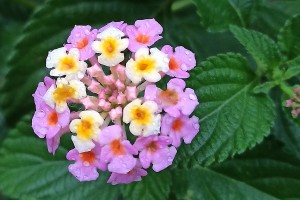Lantana leaf rust
History in New Zealand
Lantana leaf rust is native to Brazil and affects mainly the common pink-flowering lantana variety. It was first released in Australia in 2001 and it has successfully established in Queensland and New South Wales. The rust prefers moist sites where there is dew or light rain, and temperatures are mild. Permission to release the lantana leaf rust in New Zealand was granted by the EPA in 2012. The rust was imported from Australia in 2013 by Manaaki Whenua – Landcare Research. Field releases began in autumn 2015 and the rust is now well established in Northland.
Lantana leaf rust has been released in conjunction with the lantana blister rust (Puccinia lantanae). The moisture and temperature requirements of these two rust species are different so they are expected to operate in slightly different climate zones or micro-climates in the field. But in both cases, the climate requirements that the rusts need are typical of those prevailing in lantana habitats here.
How would I find/recognise it and what is the lifecycle?
Pustules should appear 3 weeks after infection and are easiest to find on the 3rd leaf pair from the tip, on the underside of the leaf. Rust pustules are slightly raised brown dots, much like coffee granules. The topside of the leaf may show some yellowing around the rust pustule. With lighter or establishing infestations, the rust pustules may only be seen by close inspection of the underside of the leaf using a hand lens. Although infection can occur all year, symptoms may not always be visible. Pustules are easier to find in the wetter seasons of spring and autumn.
Image: lantana leaf rust under-side of leaf.
Image: lantana leaf rust top-side of leaf.
In its native range, lantana leaf rust mostly forms urediniospores and can persist through this type of spore alone. Teliospores are only found in high-altitude areas in their native range and in areas with low temperatures in Australia. In such adverse conditions, this type of “resting spore” may improve the ability of the rust to survive.
When urediniospores land on lantana leaves, they germinate and grow into the plant. Infected areas turn yellow after 2 weeks and after 3 weeks, pustules of new urediniospores erupt through the epidermis, damaging the leaves. New urediniospores continue to be formed in these pustules for at least 48 days. The wind disperses these spores, spreading the disease around.
Image: lantana plant infected with lantana leaf rust.
The only fungus you might confuse with the lantana leaf rust is the lantana blister rust which has much larger pustules.
See Lantana blister rust.
Will it attack other plants?
The lantana leaf rust is unlikely to damage plants other than Lantana camara.
How does it damage lantana?
Pustules produced on the underside of the leaves damage the leaves eventually causing leaf death and defoliation.
How effective is it?
The rust is defoliating lantana plants at sites in Northland during the cooler months of the year. This is weakening the plants and reducing their ability to produce berries.
How can I get the most out of it?
Lantana leaf rust can reproduce relatively quickly and disperse by wind, so it should spread quite rapidly but some subsequent redistribution efforts may be required if natural infection does not occur in all areas where the rust is needed. Lantana leaf rust relies on moisture to germinate and commence its life cycle. If possible, the leaves should be regularly wet from dew, fog or rain. The spores need a wet leaf surface for a minimum of 8 hours to germinate. Therefore, the best conditions for release would be during light rain sustained over a few days, with likely follow-up rain. Ideally, applications should be timed for late afternoon when rain is expected or when dew occurs overnight to stimulate spore germination. Alternatively, enclosing inoculated branches with plastic, or spraying plants with water may help with initial establishment in dry conditions.
How do I select a release site?
Read Guidelines for selecting release sites for biocontrol agents.
Lantana leaf rust requires a period of moisture to germinate and infect. Sites in gullies and under canopy will retain moisture for longer. Avoid full sun as extreme temperatures are undesirable for rust survival. The lantana plants at the site must be the susceptible pink-flowering varieties, not wilting, and actively growing.
How do I collect it for release at other sites?
Collect spores into a small container using a fine paintbrush. Mix the spores with some talc powder and brush the spore mixture on the underside of young leaves.
How do I manage the release sites?
Avoid any activities that will interfere with the rust, such as herbicide application. If you need to undertake control measures avoid the release site.
